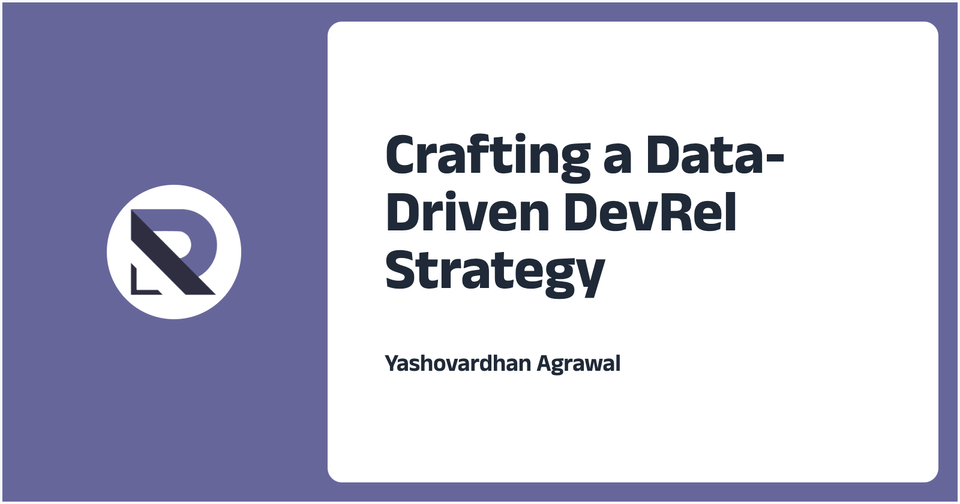Crafting a Data-Driven DevRel Strategy

When I joined Web3Auth, my first few months were focused on understanding the Web3 ecosystem and diving deep into the technology behind Web3Auth’s core offering. As a frontend SDK, it was critical to grasp how it worked and why developers would want to use it. This hands-on approach not only helped me understand the product but also laid the foundation for crafting an effective Developer Relations strategy.
Over time, I realized that building a DevRel strategy isn’t just about intuition, it’s about leveraging data and aligning efforts with developer needs.
The Foundation of a DevRel Strategy
As mentioned earlier, my initial focus was on hands-on experience with the product to grasp its intricacies and underlying reasons. As a developer relations professional, I firmly believe that the priority should be to interact with the product to comprehend the thought process behind its integration.
This practice not only helped me in structuring the documentation, guides, and other content effectively but also enabled me to provide valuable feedback to the product team on enhancing the product’s user-friendliness.
Over my years at Web3Auth, my team and I have consistently maintained this practice. Before each release, the individuals directly responsible for an SDK conduct a thorough integration test to ensure the product’s readiness for production by the engineering team. Additionally, we organize an internal session where the entire team is informed about the new changes introduced in a particular release.
This makes sure that overall consistency is maintained in terms of the offering across our various product and platform-specific SDKs.
Key Metrics That Shaped Our Strategy
- First Impression: We followed the journey of a developer who encountered our product and observed their progress from initial exploration to successfully integrating our SDK. This analysis for multiple personas revealed areas where our onboarding process and the content surrounding it needed improvement.
- Drop-Off Rate: The ratio of developers signing up on our dashboard vs making their first working integration with us. When I joined, 80-90% of developers dropped off before completing their first integration. Through iterative improvements, we reduced this to 20-30%.
- Worthy Engagement: As a startup, we had limited resources to allocate towards community programs. Consequently, our primary focus shifted towards tailoring our offerings to meet the specific needs of a paying customer rather than engaging with smaller community members. While this approach may not be ideal, it was necessary to prioritize business objectives in the face of resource constraints.
Core Principles of Our DevRel Strategy
While there are numerous challenges to address in any product and community experience, there’s so much you can accomplish at any given point. Therefore, to ensure exceptional usefulness, we established some fundamental principles that guided our Developer Relations Strategy.
The 5-Minute Rule
Developers have limited attention spans, so we aimed to make basic working integrations possible within five minutes.
Ensure developers can achieve a meaningful outcome with your product in under five minutes.
Content as a Cornerstone
Content became the backbone of our strategy. We focused on creating structured resources like API documentation, quick-start guides, and examples while also investing in unstructured content like blogs, tutorials, and community-driven contributions.
Great content strategy is not just about well-structured documentation for your project, it is about creating resources that cater to different levels of expertise and use cases.
Specified Event Strategy
Since events are a huge cost for the company, other than the business goals, as the DevRel team, we used events strategically:
- Online Events focused on education and content marketing
- Offline Events, like conferences focused on relationship-building and evangelism
- Hackathons were majorly used for real-world product usability testing and developer experience
Events are not just marketing opportunities; they’re platforms for direct interaction with your community.
Community Programs
We built community programs around the 90:9:1 rule:
- 90% Lurkers: General folks that consume your resources and content
- 9% Contributors: Community Members who come in and engage with your content/ programs
- 1% Advocates: Exceptional members who actively participate and help others engage deeply with your product
Segment your community engagement efforts to address different levels of participation effectively.
Key Takeaways for Aspiring DevRels
- Be Hands-On With Your Product: As a DevRel professional, you must experience your product as an end developer would. This helps identify pain points and improves feedback loops with engineering teams.
- Leverage Data for Decision-Making: Metrics like onboarding success rates or drop-off points provide actionable insights into where improvements are needed.
- Iterate Constantly: A DevRel strategy is never static—it evolves based on developer feedback and ecosystem changes.
- Align With Business Goals: While focusing on developer experience is critical, ensure your efforts align with broader company objectives like adoption rates or customer retention.
Crafting an effective DevRel strategy requires empathy for developers, a data-driven mindset, and continuous iteration. At Web3Auth, this approach helped us bridge gaps between sign-ups and successful integrations while building a thriving community around our product. Whether you’re starting from scratch or refining an existing strategy, remember: to focus on understanding developer pain points first and let data guide your decisions.

